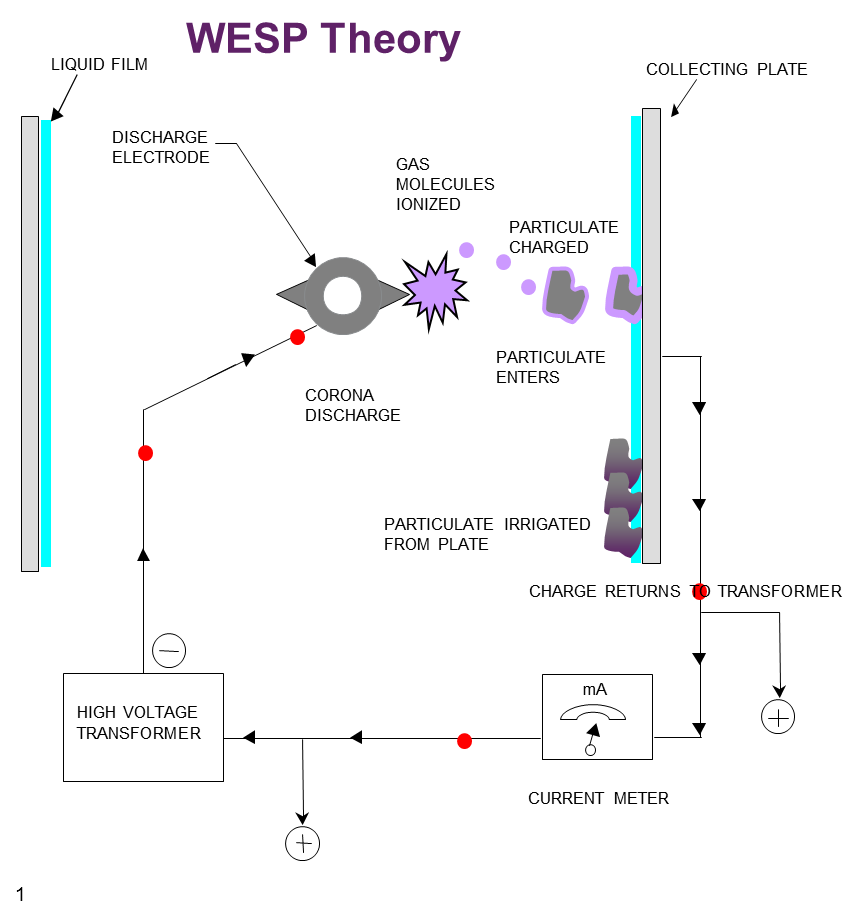Particulate Control
Wet Electrostatic Precipitators
Benefits
- High degree of customization to meet customer needs
- Removal of fine particles and acid mist
- Durable and long lasting alloy construction
- Full penthouse/insulator enclosure for ease of maintenance
- Intermittent spray washing capability as secondary means of cleaning
- Continued support training, startup, tuning, inspections and more
Wet Electrostatic Precipitators (WESP) are polishing devices to remove fine particles and condensed aerosols such as sulfuric acid mist. Our Wet ESP technology dates back to the 1970’s with first installations on coal tar units. We have since built upon this technology with our acquisition of Croll-Reynolds Clean Air Technologies.
We offer both a horizontal flow design for large utility and industrial applications and a vertical flow modular design for smaller applications.
Our reference list includes 70+ industrial units and 2.6 GWe of utility boilers including 2 installations on 800 MWe coal-fired boilers
Applications
- Utility Boilers 2.6 GWe
- Chemical & Plastics (haz waste, incinerator, plastics manufacturing)
- Electronics (fiber optic, semiconductor)
- Food Process (corn, chicken, grappa, peanut roast)
- Metals & Mining (ore roasting, steel recovery, phosphate production)
- Used for removal of:
Solid particles: PM2.5 into sub-micron range
Aerosols: H2O, H2SO4, condensed organics
Metals: SVM, LVM, particulate Hg - Does not collect:
Acid gases: SO2, HCl, HF
VOC: non-condensed organics
Metallic vapors: non-condensed inorganics
- Last air pollution control device – “polishing device”
- Saturated flue gas environment, temperature < 150°F (65°C)

HIPWESP (Horizontal Irrigated Plate WESP)
Features
- Horizontal gas flow for wide range of gas volumes
- Multiple electrical sectionalization for high removal capability
- Continuous collecting plate irrigation provides superior performance to spray cleaning designs
- Intermittent spray washing for corrosion protection of wetted equip
- Vertical, shop assembled collecting curtains. Alloy construction.
- 2 or 4 pt high voltage suspension
- Rigid discharge electrodes for increased performance and enhanced reliability
- Full penthouse/insulator encl.
- Access at top and bottom of fields

Condensing WESP
Features
- Vertical gas flow for small footprint
- Superior performance to spray cleaning designs due to continuous plate irrigation via condensation
- Intermittent spray washing capability as secondary means of cleaning
- Modular construction for ease of installation. Rectangular or round.
- Round tubes for symmetrical electrical field
- 4 pt high voltage suspension
- Rigid discharge electrodes for increased performance and reliability
- Multiple electrical fields possible
- Pre-conditioning via water sprays or scrubbing
How it Works
.

Step 1: Charging
- Gas ions formed by corona discharge
- Particulate charged by gas ions
Step 2: Collection
- Ions transport particles to collect plate
- Particulate charge given to collect plate
Step 3: Cleaning
- Particulate trapped in liquid film
- Collecting plate continuously irrigated
Special Features

Rigid Discharge Electrode (RDE)
- Virtually unbreakable design – superior to wire-type designs in performance and reliability
- Sharp pointed corona generators to combat current suppression

Continuous Irrigation and Collecting System
- Special collection plate design promotes complete water coverage along height of collecting curtain
- No particulate buildup allows for maximum amount of power input into the WESP = enhanced performance and smaller WESP

Full penthouse/insulator enclosure for easy access and maintenance
Recent Projects

Peabody Prairie State
Location: Lively Grove, IL, USA
Customer: Prairie State Energy
Design: 2 x Plate Horizontal Flow
Capacity: 2 x 800 MWe
Start-Up Year: 2011
Fuel: Bituminous Coal
Gas Flow: 2 x 2,265,000 ACFM
(2 x 3,848,259 m3/hr)unt.

City of Springfield Dallman
Location: Springfield, IL, USA
Customer: City of Springfield
Design: Plate Horizontal Flow
Capacity: 200 MWe
Start-Up Year: 2009
Fuel: Bituminous Coal
Gas Flow: 640,000 ACFM
(1,087,366 m3/hr)

PCS Phosphate Aurora
Location: Aurora, NC, USA
Customer: PCS Phosphate
Design: Tubular Vertical Flow
Start-Up Year: 2001-2003
Gas Source: Phosphate Calciners
Gas Flow: 6 x 71,600 ACFM
(6 x 122,000 m3/hr)

LG&E Trimble County 2
Location: Trimble County, KY, USA
Customer: LG&E
Design: Plate Horizontal Flow
Capacity: 750 MWe
Start-Up Year: 2010
Fuel: Bituminous,
Sub-Bituminous Coal
Gas Flow: 2,100,000 ACFM
(3,567,922 m3/hr)
Talk with a technical specialist
Your questions are our priority. For general inquiries please add your question below and we’ll be in touch.
For spare parts inquires please email us directly at spareparts@woodplc.com, please include the part number and serial / job number with your inquiry.
